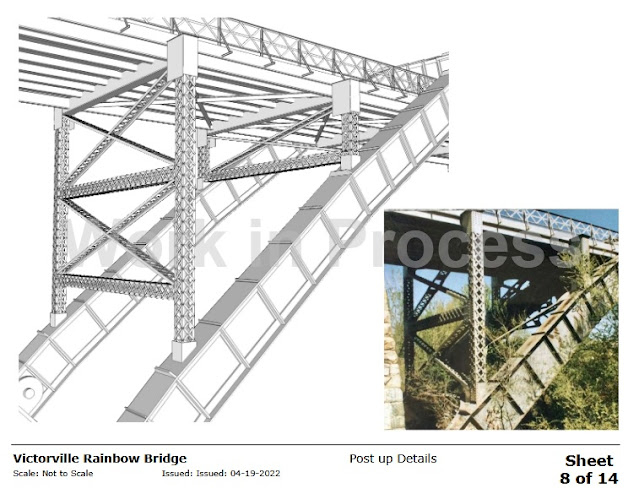Our Victorville locomotives this time are the Santa Fe's big 3776-class 4-8-4s, and my layout progress involves painting all of the mainline roadbed in staging.
The Santa Fe had four classes of 4-8-4 steam locos, and the 3776 class was the third class received, consisting of 10 locos, #3776-3785, delivered by Baldwin in 1941. They had longer oil tenders (24.5K gallons of water) than the previous 3765 class, and they were almost identical to the following 2900 class, but not as heavy.
In the postwar years on Cajon Pass, they were normally seen pulling the secondary passenger trains. Here we see #3784 with a heavyweight train by the 6th Street grade crossing in Victorville, thanks to Chard Walker:
#3784 and 3785 were delivered with the thin roller-bearing rods you see here, and the other eight locos got them in 1946-1948.
Here is Chard Walker's photo of #3785 coming westbound through the Upper Narrows with the Fast Mail:
Here we see a Donald Duke photo of #3777 with the California Limited climbing westbound from the Upper Narrows:
Donald Duke also shot #3781 with the Chief as it climbs toward the Frost Flyover outside Victorville:
Here we see #3776 waiting at Summit with the Grand Canyon, while its helper, 2-8-2 #3151, cuts off and moves to the engine spur, thanks to Chard Walker:
Here's a Jim Ady photo of #3776 and a later 4-8-4, #2925, pulling a Shriners Special westward from Victorville to Summit in June, 1950:
Here we see #3781 with the westbound Fast Mail approaching Summit, as shot by Bob Hale in the early 1950s:
We'll end with Stan Kistler's great shot of #3785 climbing west from the Upper Narrows with the Fast Mail:
During 1949-1952 six of the locos got new boilers with no external steam dome. A few of Santa Fe's 4-8-4s lasted on Cajon Pass into 1953, but the last date I can find for a 3776-class loco on Cajon is 1951.
The earliest HO brass models of these locos were imported by PFM from 1963 to 1982, and I have five of these (they were relatively cheap). Two of mine have the roller-bearing rods and are painted, but the other three are still waiting and hoping for paint someday. Here is a painted PFM model with roller-bearing rods
Hallmark made some Super Crown models with various features (too expensive for me). Here is one with tapered rods:
Finally, Bachmann made a styrene model of the 3776 class locos, as seen here:
Now let's look at my layout progress during the last two weeks. My friend Tim Fisher advised me to avoid the bump from the 5mm roadbed cork up to the 6mm carpet cork, so I set aside the carpet cork and dropped my plans for cutting out all those triangular cork shapes you saw last time. Instead, I bought 90 sq. ft. of 5mm sheet cork from a place on the Internet named Cleverbrand and waited for that.
In the meantime, my new task was to paint the double-track mainline roadbed a light gray color, using the same paint I used in the staging room over a year ago. I began where the mainlines leave the staging room, and I worked my way around the layout from there.
Here's a view looking out from the staging room into Section 8 after the first week (I laid the turnouts in place after the paint was dry):
I used a wider brush on the tops of the roadbed and a narrower one along the beveled edges. I sanded the tops of the cork and sharpened the edges with a putty knife before painting each section.
Here's the next view looking back as I gradually progressed around the curves in Section 1:
The painting continued every day during the second week. The 30 sheets of 5mm cork arrived early in the week, as seen stacked here near the newly-painted mainlines in Sections 5 and 6:
Also, I got lucky on eBay and won a set of 30 used Atlas code 100 #6 turnouts (15 left and 15 right), all with powered switch machines attached. They arrived later in the week, and here they are beside the painted roadbed in Sections 3, 4, and 5:
Finally, here's a view of the painted roadbed looking toward Sections 2 and 3 on the left and Sections 7 and 6A on the right:
Another big event a week ago was receiving the beautiful HO model of Mojave Northern 0-6-0T #3 that I bought from Tom Coletti when he decided to change scales. I posed it by the M.N. rock cars that my friends built for me last year (this photo was taken in my staging room, where only three storage tracks are down):
You can read more about how Tom built this unique model here:
https://www.trainboard.com/highball/index.php?threads/scratch-bash-mojave-northern-railroad-0-6-0t-no-3.82339/
I shot another photo like this for Jim Coady to include in his article about how he 3D-printed the parts for the rock cars, which he has submitted to Railroad Model Craftsman. I helped him edit the draft of his article.
My final bit of news is that Jim Coady has completed his CAD drawings of the Rainbow Bridge, at least for now. Here's a sample page showing the amazing details he has included:
I'm now beginning to work with him as he draws plans for the boiler house that was inside the Victorville wye.
Next week I want to start laying and wiring the mainline tracks and building the mainline control panels.


















No comments:
Post a Comment